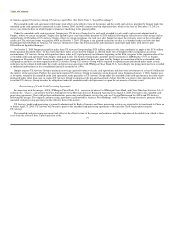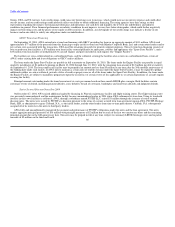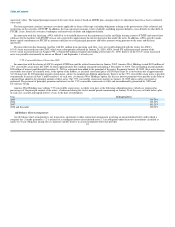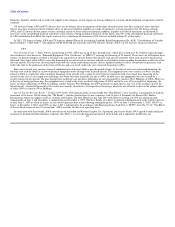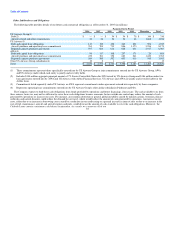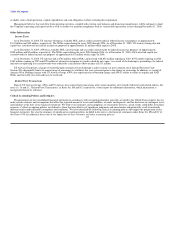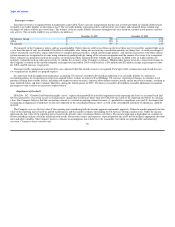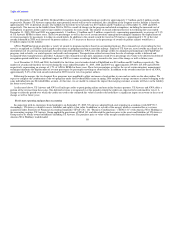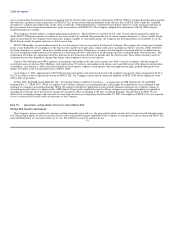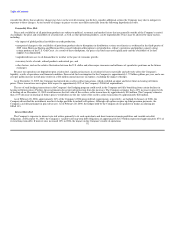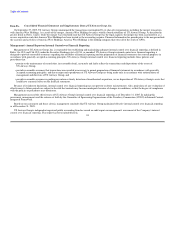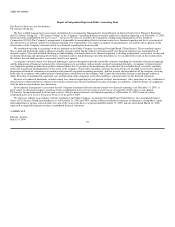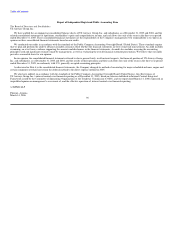US Airways 2005 Annual Report Download - page 93
Download and view the complete annual report
Please find page 93 of the 2005 US Airways annual report below. You can navigate through the pages in the report by either clicking on the pages listed below, or by using the keyword search tool below to find specific information within the annual report.
Table of Contents
assumptions could materially affect the determination of fair value and/or goodwill impairment. Actual future results may differ from those estimates.
At December 31, 2005, goodwill represents the purchase price in excess of the net amount assigned to assets acquired and liabilities assumed by America
West Holdings on September 27, 2005. Since that time, there have been no events or changes that would indicate an impairment to goodwill. The Company
will perform its next annual impairment test on October 1, 2006. At December 31, 2004, goodwill represents the excess reorganization value resulting from
the application of SOP 90-7 upon emergence from US Airways' first bankruptcy. US Airways concluded that the fair value of the reporting unit was in excess
of the carrying value and therefore not impaired during 2004. Cash flow projections for US Airways' 2004 test were prepared on a going-concern basis.
Additionally, in the third and fourth quarters of 2004, the carrying value of US Airways' net assets was less than zero. See Note 2(g) to the US Airways'
financial statements included in Item 8C of this report for details regarding past goodwill impairment tests.
Impairment of long-lived assets and intangible assets
We assess the impairment of long-lived assets and intangible assets whenever events or changes in circumstances indicate that the carrying value may not
be recoverable. Factors which could trigger an impairment review include the following: significant changes in the manner of use of the assets; significant
underperformance relative to historical or projected future operating results; or significant negative industry or economic trends. An impairment has occurred
when the future undiscounted cash flows estimated to be generated by those assets are less than the carrying amount of those items. Cash flow estimates are
based on historical results adjusted to reflect management's best estimate of future market and operating conditions. The net carrying value of assets not
recoverable is reduced to fair value. Estimates of fair value represent management's best estimate based on appraisals, industry trends and reference to market
rates and transactions. Changes in industry capacity and demand for air transportation can significantly impact the fair value of aircraft and related assets.
Frequent traveler programs
US Airways' Dividend Miles frequent traveler program awards miles to passengers who fly on US Airways, US Airways Express, Star Alliance carriers
and certain other airlines that participate in the program. US Airways also sells mileage credits to participating airline partners and non-airline business
partners and defers the portion of revenue attributable to future transportation. US Airways has an obligation to provide this future travel and has therefore
recognized an expense and recorded a liability for mileage awards to passengers redeeming on US Airways or an airline partner. Outstanding miles may be
redeemed for travel on any airline that participates in the program, in which case US Airways pays a designated amount to the transporting carrier.
Members may not reach the threshold necessary for a free ticket and outstanding miles may not be redeemed for free travel. Therefore, US Airways
estimates how many miles will never be used for an award and excludes those miles from the estimate of the liability. A portion of the mileage credits of
Dividend Miles participants who have excessive balances are also excluded from the liability. Estimates are also made for the number of miles that will be
used per award and the number of awards that will be redeemed on partner airlines. These estimates are based upon past customer behavior. Estimated future
travel awards for travel on US Airways are valued at the estimated average incremental cost of carrying one additional passenger. Incremental costs include
unit costs for passenger food, beverages and supplies, credit card fees, fuel, communications, insurance and denied boarding compensation. No profit or
overhead margin is included in the accrual for incremental costs. For travel awards on partner airlines, the liability is based upon the gross payment to be paid
to the other airline for redemption on the other airline. A change to these cost estimates, actual redemption activity or award redemption level could have a
material impact on the liability in the year of change as well as future years. Incremental changes in the liability resulting from participants earning or
redeeming mileage credits or changes in assumptions used for the related calculations are recorded as part of the regular review process.
87


